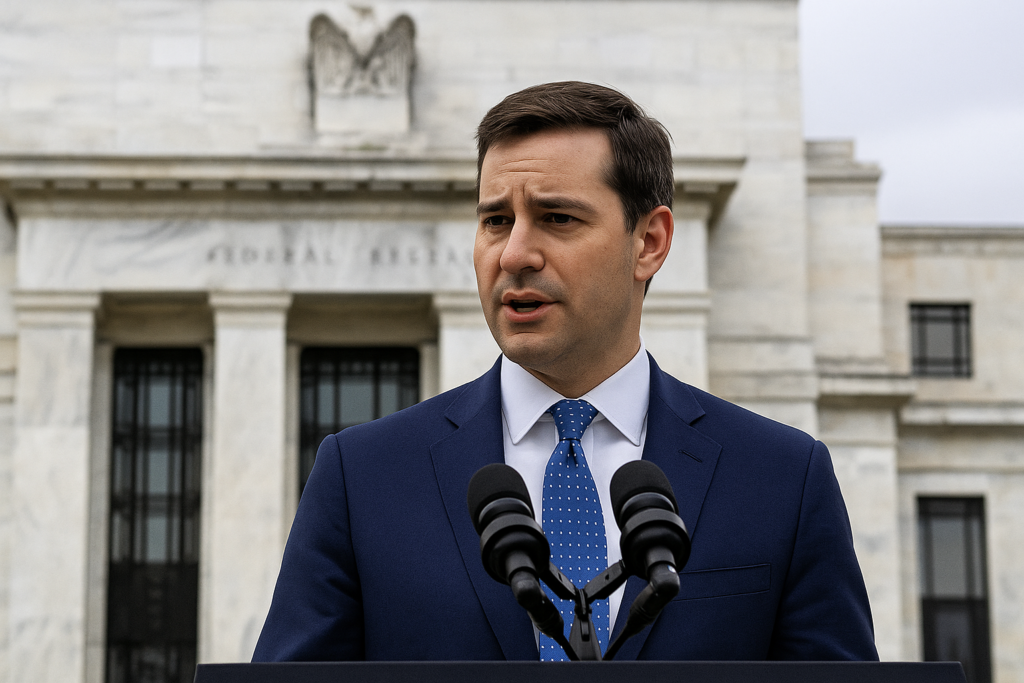In a bold new statement, Federal Reserve Governor Stephen Miran said that U.S. inflation is declining faster than official reports indicate, calling for an immediate 0.5% interest rate cut at the Fed’s upcoming December meeting.
Miran, a respected economist and former Treasury official, argued that the central bank risks “keeping rates too high for too long”, potentially slowing economic recovery and stifling job growth.
“Our data show inflation has already returned close to target levels,” Miran said. “It’s time to act — the economy needs relief, and waiting too long could push us into unnecessary weakness.”
Table of Contents
📉 1. Inflation Falling Faster Than Expected
According to Miran’s analysis, core inflation — which excludes food and energy — is now running below 2.3% on a three-month annualized basis, significantly lower than the official 3.2% year-over-year rate reported by the Bureau of Labor Statistics.
Miran cited alternative price indices, such as the Cleveland Fed’s median CPI and private-sector datasets, showing disinflation across multiple sectors including housing, energy, and goods.
“We’re seeing a lag in how official statistics capture the cooling in rent and service prices,” Miran explained. “Real-world inflation is already much lower.”
This data suggests the Fed may have overestimated persistent inflation, strengthening the case for a rate reduction.
💡 2. Why Stephen Miran Is Calling for a Rate Cut
Miran’s remarks come amid growing internal debate within the Federal Reserve Board of Governors. While Chair Jerome Powell has signaled caution, Miran argues that keeping rates elevated at 5.25%–5.50% risks creating a “policy overshoot.”
“When real rates remain high while inflation falls, monetary conditions tighten automatically,” he said. “That’s effectively an unintentional rate hike.”
He added that a 0.5% cut in December would bring policy back into alignment with the economy’s cooling trajectory — balancing inflation control with growth stability.
Miran also pointed out that credit conditions are already tightening, with loan delinquencies rising and business investments slowing across small and medium-sized firms.
📈 3. Reaction from Financial Markets
Financial markets responded positively to Miran’s statement, with major indices rising in early trading:
- Dow Jones Industrial Average: +1.2%
- S&P 500: +0.9%
- Nasdaq Composite: +1.4%
The U.S. 10-year Treasury yield fell by 12 basis points, reflecting investor expectations of a potential December policy pivot.
Meanwhile, Bitcoin and gold both saw small upticks as traders priced in a more accommodative monetary outlook.
“Markets love the idea of a faster rate cut,” said JP Morgan strategist Helen Liu. “It reinforces the soft-landing narrative that inflation is tamed without triggering a recession.”

🧠 4. What Analysts Are Saying
Economists across Wall Street and academia are divided over Miran’s call.
Some agree that inflation is cooling faster than data shows, while others warn against premature easing that could reignite price pressures in 2026.
- Goldman Sachs analysts estimate underlying inflation will fall to 2.4% by January, supporting Miran’s case.
- Morgan Stanley remains cautious, projecting the Fed won’t cut rates until March 2026.
- The Chicago Fed’s economic activity index, however, has slipped to its lowest level in a year — signaling softening growth momentum.
“Miran is ahead of the curve,” said economist Dean Baker. “If his models are right, the Fed needs to move before the slowdown turns into a contraction.”
💬 5. What This Means for the U.S. Economy
If Miran’s proposal gains support, a 0.5% December rate cut would mark the first major policy reversal since the aggressive tightening cycle that began in 2022.
Such a move could:
- Ease borrowing costs for consumers and businesses.
- Boost housing demand, which has suffered under high mortgage rates.
- Strengthen stock market performance into year-end.
However, critics caution that lowering rates too quickly could undermine credibility if inflation rebounds.
“It’s a delicate balancing act,” said economist Diane Swonk. “The Fed must ensure it’s not cutting into a rebound.”
Still, Miran insists the risk of inaction now outweighs the risk of easing too soon.
“If inflation has already normalized,” he said, “then maintaining restrictive policy is a mistake we’ll regret.”
🧭 Conclusion: A Turning Point for the Federal Reserve
The Stephen Miran Inflation Report could mark a turning point in the Fed’s policy trajectory.
With inflation data cooling faster than anticipated and the economy showing early signs of strain, Miran’s call for a 0.5% December rate cut may set the stage for a broader policy shift in 2026.
“It’s time for a recalibration,” Miran concluded. “The data tells us the fight against inflation is largely won — now we must focus on sustaining growth.”
Read more
